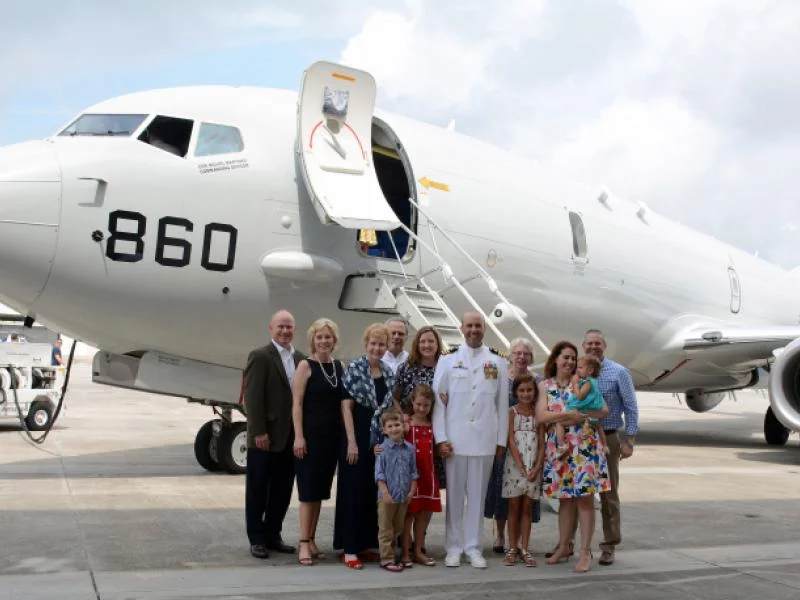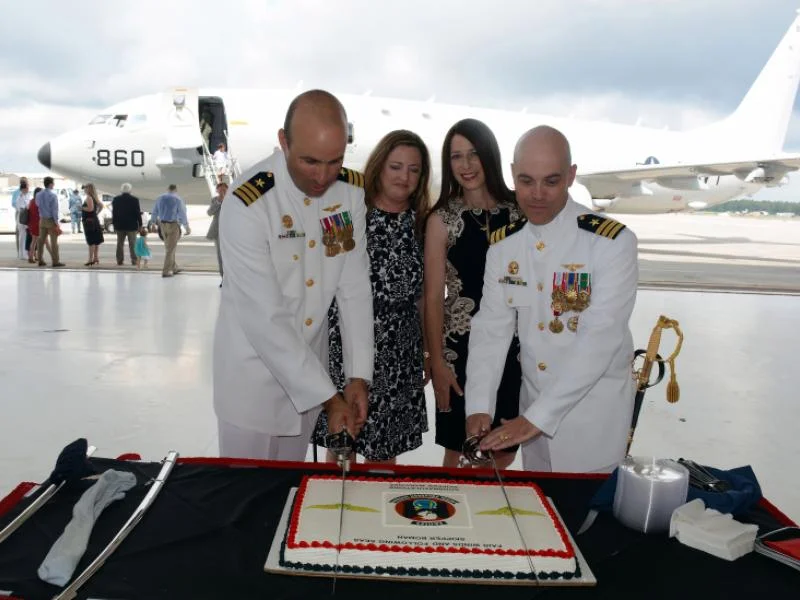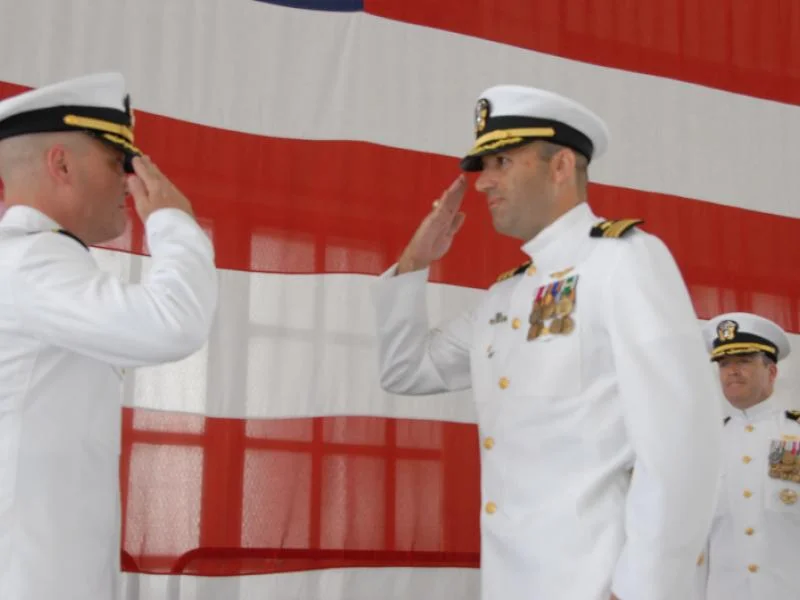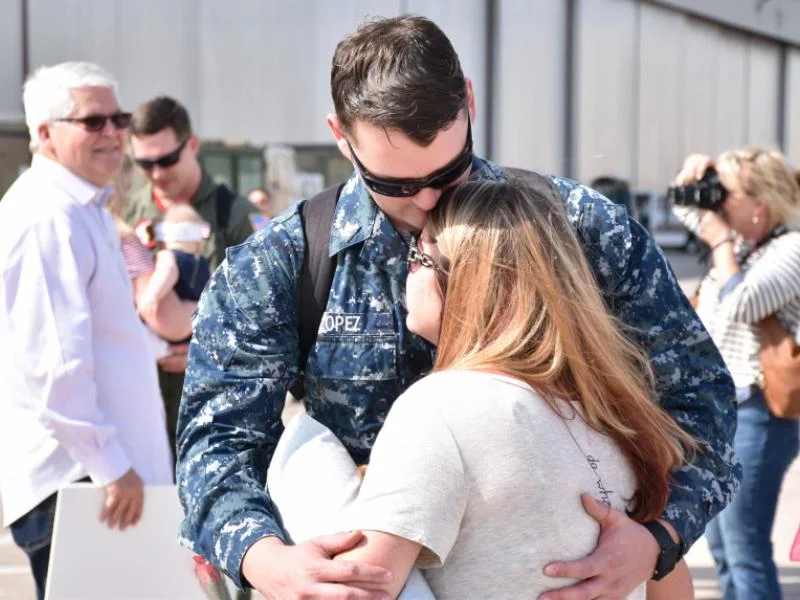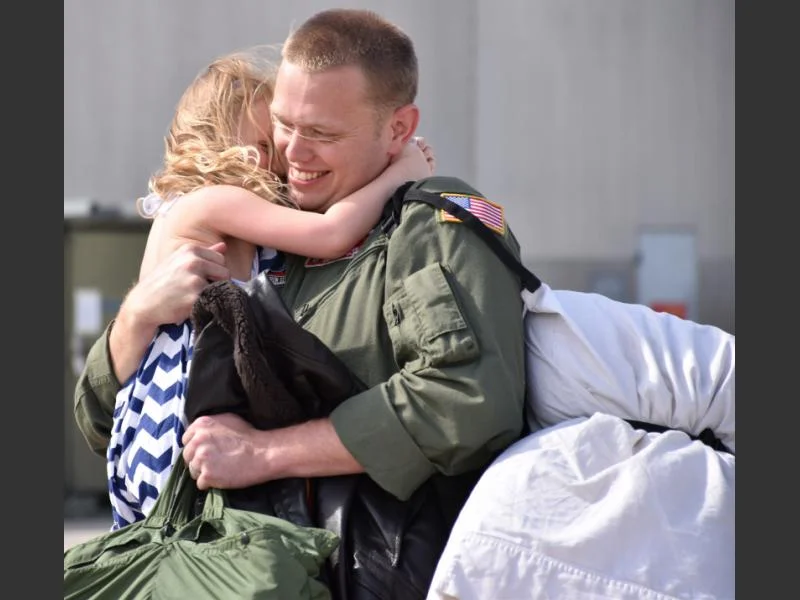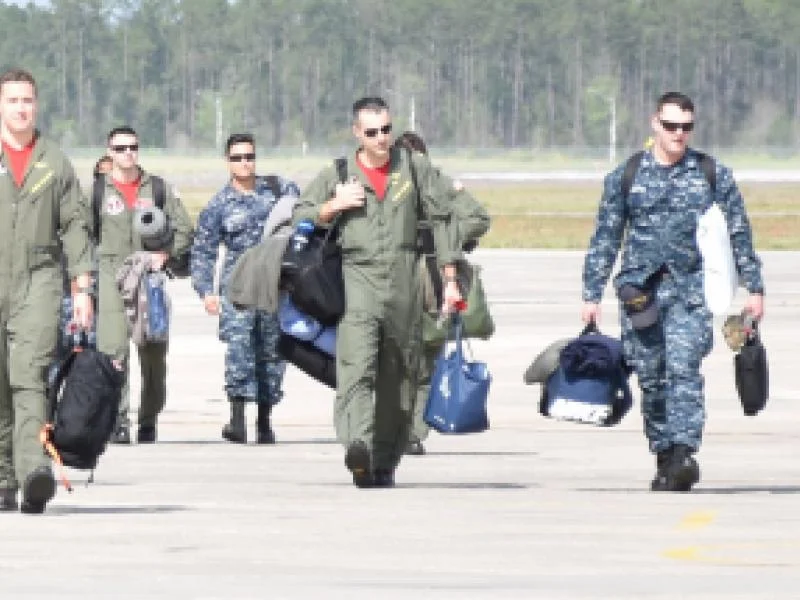2016-06-06 By Robbin Laird and Ed Timperlake
During our visit to Jax Navy On 22 and 24 May, we had a chance to meet with and discuss the P-8/Triton with Commander Miguel Martinez, CO of Patrol Squadron 16 and Commander Amanda Hawkins, the Executive Officer of the Squadron.
The Command has just undergone a Change of Command on May 19th.
According to an article published by the VP-16 PAO:
Cmdr. Mike Martinez relieved Cmdr. Dan Boman as the 62nd commanding officer of Patrol Squadron (VP) 16 during a May 19 ceremony in Hangar 117 at Naval Air Station Jacksonville.
VP-16 is the Navy’s first operational Maritime Patrol and Reconnaissance Force (MPRF) squadron to deploy with the P-8A Poseidon – a modified Boeing 737 aircraft designed to supersede the war-fighting capabilities of its predecessor for 50 years, the P-3C Orion.
Poseidon’s primary missions include anti-submarine warfare, anti-surface warfare, and intelligence, surveillance and reconnaissance.
Martinez assumed executive officer duties at VP-16 in May 2015, during the Inter-Deployment Readiness Cycle that followed the squadron’s inaugural P-8A deployment to 7th Fleet. He commended the War Eagles’ former commanding officer.
“I want to pass along my congratulations to Skipper Boman and his family for an amazingly successful command tour. It was my honor to serve under his command and the leadership that he provided to every Sailor in VP-16. That resulted in our outstanding recent deployment to 7th Fleet and set the stage for the squadron’s future success.”
During Boman’s command of VP-16, the squadron completed its second deployment in the P-8A to Kadena Air Base in Okinawa, Japan in support of 7th Fleet operations. Over the deployment, 3,700 flight hours were safely executed without a single class “A” mishap.
Martinez graduated from Texas A&M University in 1998 with a bachelor’s degree, and received his Naval Flight Officer (NFO) “Wings of Gold” in July of 1999. He reported to the “Skinny Dragons” of VP-4 in Kaneohe Bay, Hawaii, in May of 2000 for his first operational tour. He completed deployments to 7th Fleet and 5th Fleet immediately after 9/11 in support of Operation Enduring Freedom.
He reported to VP-30 in May 2003 for duty as a Fleet Replacement Squadron NFO Instructor. Additionally, he served on board the USS Theodore Roosevelt as a catapult and arresting gear officer. He also studied at the Naval War College in Newport, Rhode Island.
Martinez assumes command of VP-16 following the end of a seven month deployment to Kadena Air Base in Okinawa, Japan. As the new commanding officer, Martinez takes responsibility for nearly $1 billion of naval aircraft and personnel. He will lead more than 250 Sailors during the next tour.
Martinez is joined by the squadron’s new executive officer, Cmdr. Amanda Hawkins. Boman’s next assignment will be in Washington D.C., as a staff member for the Office of Chief of Naval Operations.
In the perspective of the CO, VP-16 has completed its transition from a P-3 to the P-8A era.
The squadron has successfully completed its first two deployments at sea.
“VP-16 is at the tail end of its transition. It takes a while to transition philosophically in the squadron.
Now that we’re on the tail end of our second deployment, we’ve really completed our transition because the operators that you’re seeing in the squadron, especially the junior officers and some of our junior enlisted operators, only know the P-8A.
We are taking the ASW skill sets and melding them with the new technology and new sensors onboard the P-8A.”
He emphasized as well that the evolution of software aboard the software upgradeable aircraft was part of the ongoing transition which might be characterized as a “permanent revolution,” if what is being experienced to date is continued into the future.
“We have just completed our second deployment.
A lot of the capability on that deployment did not exist during the first.
And the main difference was because of software upgrades.”
And as they prepare for their next deployment, more software upgrades are under way.
And the CO commented that the “operators are telling me that we will have capabilities through the software upgrades that would have been extremely useful during the last two deployments.”
To date, the working relationship between the squadron and industry is working well in updating the aircraft through the software development process.
“I would tell you part of the reason that exists is because everyone’s invested in the success of P-8A.
Boeing and a lot of the companies that are involved in software upgrades, they want us to succeed.”
The CO expressed his concern that the success to date needed to be maintained throughout the course of the program to get the full value of what a software upgradeable aircraft could yield to the force.
“We have fleet support techs and fleet support reps that support us on deployment and here at home.
And it’s a direct tie-in back to the software developer as he’s pumping out new software updates and they’re getting ready software for our allied partners: UK and Australia.
It’s a very direct inject.”
He provided an example of how the process worked on deployment.
“We were on deployment at Kadena.
We were having difficulty with our media, and the P-8 is very media dependent; if the media is not working properly, the plane is not going to work properly.
The software representative told us that he would look at the software logs. When we burn new media, it writes logs into the computer system. He suggested that he would send the logs back to the lab and they would modify the code and fix the problem.
And they did do so rapidly. We certainly did not have that on the P-3, but we have that now.
I hope that experience continues indefinitely into the future.”
The plane is different; the sensors and software is different; but so is the work style.
When you work onto the plane, it is obvious that the operators are working on a track system with several screens adjacent to one another.
During our hands on visit to the plane, we talked to the crew and began to understand that there was an interactive team approach to managing the aircraft during operations, whereby the mission commander was more like a quarterback than a hierarchical decision maker.
The CO discussed that approach and its challenges.
“There is a certain empowerment which goes to the crew.
The mission commander has to know what is going on and off the aircraft affecting the mission.
He is doing so by empowering his crew whereby, for example, an acoustic operator will be talking to folks on the ground to determine how to deal with the acoustic reads which he getting.”
We noted that the Wedgetail which has a similar workflow to the P-8A also had experienced a similar decision making dynamic. The 2nd Squadron commander in Australia noted that the mission leader on the plane had to lead not command.
The CO noted that “that is exactly it.
With the P-8 we have the opportunity to reach back for additional brain power, for additional analysis of what we are seeing on station.
And you are collecting information from the moment you take off until the moment you land.”
We noted that when we visited the plane, the crew was very young, and very technologically competent.
The CO agreed. “When I took my family who were here for the change of command and we went onto the aircraft, they also noted that the 25-27 year old mission commanders are operating a combat aircrew in an area like the South China Sea, and making decisions and doing things that could potentially affect our national strategy.
We want them to have that knowledge, that ability to make mission command decisions on their own.”
This younger generation was very “net and information management” savvy. And the CO highlighted that their capability to navigate among information sources was very impressive but also intuitive for them.
“It is hard to overload the current generation with information.
They are just used to it.
For example, when we go on station they are looking for various ways to get into the network.
They are thinking two or three steps down the road concerning different sources and different links, which can be tapped into including coalition assets as well. There’s so many different ways to enter a network of information.
They are very savvy with regard to that task.
We discussed as well the cross learning which is starting from the P-8A to the surface fleet.
“The surface fleet is beginning to experience being on deployment with a P-8A and getting massive amounts of information from the plane in a way we never did in the past.
There is a cross-learning piece which will accelerate in the period ahead.”
We discussed other cross-learning pieces as well.
The CO emphasized that as the software evolved in the P-8A/Triton world the mix of operators onboard the P-8A will evolve as well.
And as the cross-learning with Growlers and other combat assets such as the F-35 evolved as well the skill sets would evolve onboard the P-8A.
“We are the new kid on the block and advanced Hawkeye and Growler are already out there.
We are just now tapping into our EW capability and we will clearly cross-learn and cross-link with other capabilities in the fleet.
And I think if you took a look at how the P-8A operates now versus even five years from now it’s going to be significantly different.
The crew makeup is going to be a little bit different. I think you’re going to see a different mix of operators on the aircraft, perhaps more EW operators.”
The CO discussed as well the evolution of the maintenance team for the aircraft.
Obviously, with a new aircraft determining the actual maintenance requirements takes time and with it the need to adjust procedures and personnel.
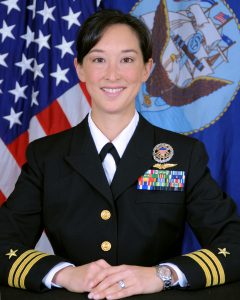
In part, this is due simply to the fact that although the 737 is a commercial aircraft, as a military version of the aircraft, much of the commercial experience simply does not apply.
Another example is corrosion control.
Clearly, the way the P-8 operates will significantly enhance the corrosion challenge. The Navy is focused on ways to attenuate the corrosion challenge but this means paying significant attention from the outset to management of the airframe.
“I think that corrosion control will be a very important factor. It’s not negative. It’s simply something that we need to keep our eye on over the long term.”
The Executive Officer is new to the program but has significant relevant fleet experience, which will inform the evolution of the squadron as well.
She focused on the “family of systems” approach and how important that would be for the squadron and its evolution.
“By 2025 we will not have EP-3 and a VPU and P-3 squadrons; we are going to morph into P-8/Triton.
We need to understand what the EP-3 does as we move forward.
We are starting the cross-colonization now so that the family already has a healthy foundation when the EP-3 roles are subsumed as well.
(The EP-3 is the signals intelligence version of the P-3).
I view the Triton and the work that the weapons school is doing to integrate our family of systems as laying the foundation for the kill web.”
The CO discussed as well two of the allies flying the P-8A.
He noted with regard to the Australians that they had a tradition of keeping their P-3 crews intact for the long term.
When I was the instructor at VP30, I worked with the allied partners and their officers and enlisted operators are embedded in the squadron, and they bring a very unique and positive side in how to operate as a crew which works together regularly on station.
They man to keep their crews together; our manning is different in that we mix and match crews members over time and will do so even more as we rotate personnel among P-8A and Triton assignments.”
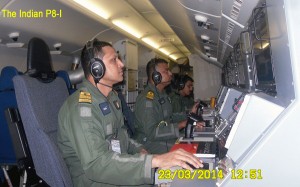
The CO has operated with the Indian P-8I community as well during the Malabar 2015 exercise.
The P-8I is different from the P-8A with a different sensor suite, one which provides more emphasis on coastal defense as well.
“We operated from their P-8I base at INS Rajali.
We found them to be very professional and we operated together from that base.
They are building the infrastructure there to support their P-8Is.
They see P-8I as critical to how they’re going to operate in the future.
They had a lot of questions about how we operated.
We had questions about how they operated.
And at the time they were the only other country operating P-8.”
In short, VP-16 has deployments under its belt and is getting ready for the transition with Triton and operating worldwide with other P-8 allies, the Indians, the Australians and the UK.
A solid foundation has been laid but the way forward is challenging and will see both the plane and the crews evolve their capabilities and skill sets.
The slideshow focuses on the recent change of command for VP-16.
And a piece published on April 27, 2016 by the PAO of VP-16 in the Jax Air News talked about the latest deployment:
Patrol Squadron (VP) 16 returned home this month after a demanding seven-month deployment to the 7th Fleet Area of Responsibility (AOR).
This marked the second deployment VP-16 has taken in the P-8A Poseidon – both deployments having been based out of Kadena Air Base, Okinawa, Japan.
VP-16 has now deployed in the P-8A Poseidon for more months and executed more deployed flight hours with the new maritime patrol aircraft than any other VP squadron in the Navy.
The deployment included detachments to a multitude of countries in the 7th Fleet AOR. Within Japan, locations such as Atsugi, Misawa, and Yokota were visited by VP-16 aircraft.
Additionally, the Republic of the Philippines, Guam, India, Brunei, Australia, Thailand and Singapore were other countries visited by the “War Eagles” during their assignment to the region. In total, VP-16 was able to safely execute in excess of 3,700 flight hours over the course of the prior seven months.
The squadron excelled in all aspects of their operations. Mission sets included Anti-Submarine Warfare (ASW), Maritime Domain Awareness (MDA), Anti-Surface Warfare (ASuW), plus Intelligence, Surveillance and Reconnaissance (ISR). VP-16 was often tasked for these mission sets since the P-8A Poseidon has a full set of intelligence collection sensors with long-range capability and extended loiter time available.
For many in the squadron, this marked their first time on deployment.
“This was my first deployment since joining the Navy. The experience was extremely rewarding because we were finally able to employ the many years of training we have undergone at NAS Jacksonville,” said Lt. j.g. Michael Reindl, a naval flight officer with VP-16. As anyone who has served can tell you, first deployments come with many new situations that can be difficult to adjust to.
For others, this was not their first experience within actual theater. AWO1 Marcus Belew, for example, was previously deployed on the P-3C Orion but embarked on his first deployment on the P-8A Poseidon this time around.
“This was my fourth deployment. Deploying with the P-8A was more tactically engaging than it was in the P-3C. We utilize our sensors from takeoff until landing, and that makes me feel that I’m able to provide a better product for the Navy as a whole.”
The response from upper level leadership to VP-16’s deployment was tremendous. The squadron was able to perform above and beyond the required levels of proficiency. Now, with VP-16 back home at NAS Jacksonville, training for their next deployment has already begun.


